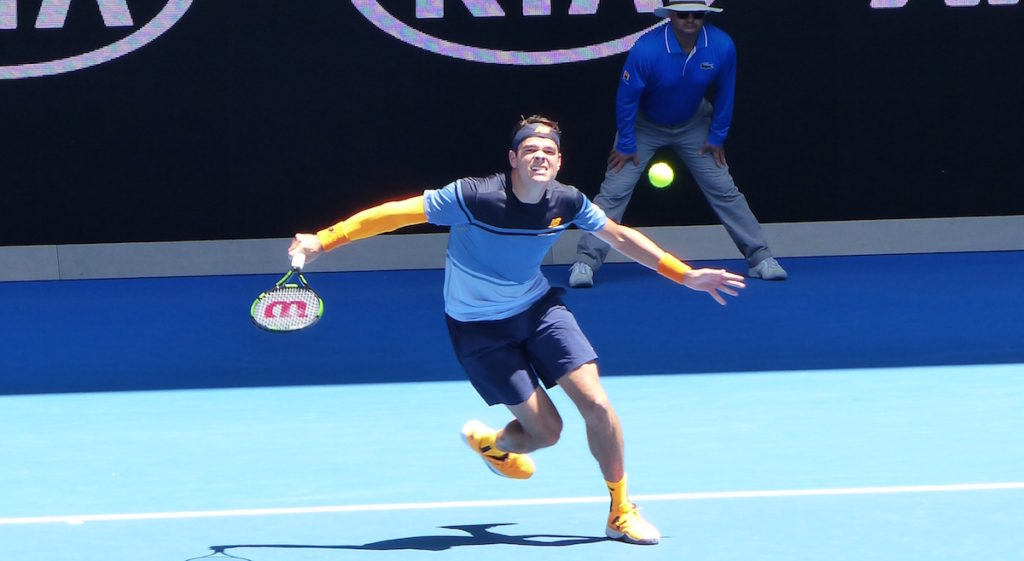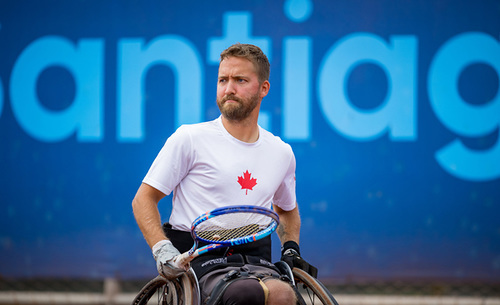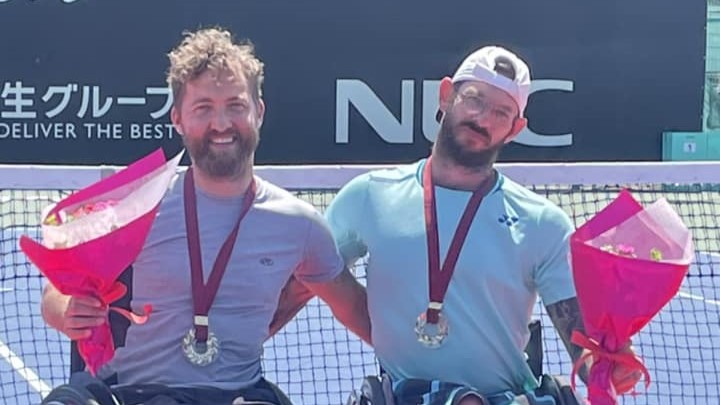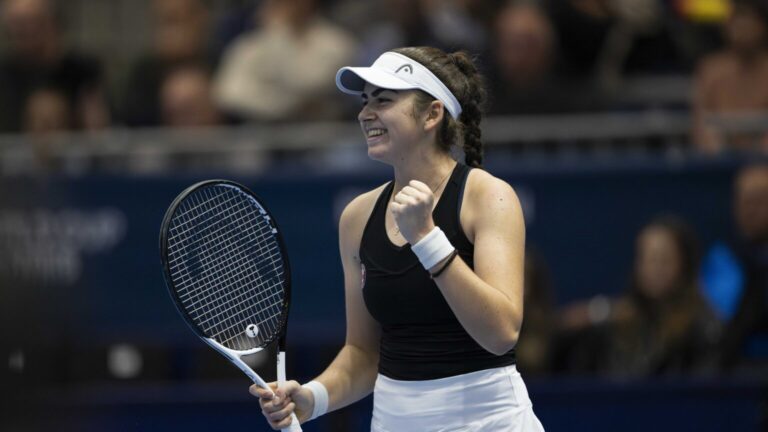
If there were an award for the most improved player at the 2016 Australian Open, it’s hard to imagine anyone being more deserving than Milos Raonic.
Certainly an argument can be made for women’s champion Angelique Kerber. She beat the two favourites to win the women’s title Victoria Azarenka and Serena Williams. But as solid as she was, there was never a sense that Azarenka or Williams were close to the top of their games.
Raonic, especially building on a victory over Roger Federer in the Brisbane International final two weeks earlier, was almost untouchable in dispatching Lucas Pouille, Tommy Robredo and Viktor Troicki to reach the round-of-16. Then it was No. 4 seed Stan Wawrinka, who later claimed to have been feeling sick but was still able to rally from a two-sets deficit and play into a fifth set in a 6-4, 6-4, 5-7, 4-6, 6-3 loss to the No. 13-seeded Raonic.
In the quarter-finals, No. 23 seed Gael Monfils hardly knew what hit him – as the new-and-improved Raonic rolled 6-3, 3-6, 6-3, 6-4 despite losing the second set.
The most impressive display by Raonic was in the semifinals, only the second Grand Slam final four of his career after Wimbledon in 2014. He led two sets to one against No. 2 seed Andy Murray and was full value. It had been a highly competitive three sets in Rod Laver Arena even if Raonic did not break serve after the first game of the match. But he was slightly better and led 6-4, 5-7, 7-6(4).
Who knows what would have happened if a right adductor injury hadn’t forced him to call for the trainer leading 2-1 in the fourth set?
With all the issues he had in 2015 – a Morton’s Neuroma foot problem that required surgery in May and back spasms that bothered him on and off for the second half of the year – it was easy to understand the raw emotion he showed in the media interview room after losing 4-6, 7-5, 6-7(4), 6-4, 6-2. “Heartbroken” is never a fun word to hear but when Raonic used it in his post-match media conference it just showed how much getting to the final meant to him.
The improvement in his game was widely recognized. There was a general feeling in the media room that he would have beaten Murray if the adductor had not acted up.
In general, his tennis took a huge step forward. His serve has always been among the best on tour. But it was the other parts of his game – backcourt play, passing shots, volleying and service returns that progressed to the point that he looked comfortable in all phases. When he rallied with Murray and Wawrinka and Monfils, there was none of that former sense that he probably would be the one to flinch first, to make the unforced error. He went toe-to-toe with Top 5 players – and his inside/out forehand was a bomb, nicely complemented by an inside/in that routinely caught opponents going the wrong way.
His volleying was so good that one astute American, a decades-long observer of the game, declared that he had the best forehand volley in tennis. Who could have imagined something like that just a few months ago?
And his return of serve was good enough to create breaks that immediately put his opponents behind the eight ball.
There was also progress in his movement. Running wide to the forehand, he seemed to be able to reach balls and stay in rallies in a way he had not in the past.
Finally, his temperament has begun to be in tune with his resolve. Raonic has always been highly ambitious but now he has a calm and control on court that’s enabling his talent to show through.
It was a great month of January for him and, as long as his health permits, the year ahead looks promising. His ranking has moved up to No. 11 from No. 14 and he clearly can threaten the best in the game – with the possible exception of that guy in the Novak Djokovic stratosphere. It’s difficult to imagine he won’t win at least two tournaments by the time this year’s US Open rolls around – with maybe one being on clay.

There wasn’t only a new look Milos on court, off court the gelled hair was gone replaced by the more breezy look above – but one that was hidden most of the time under his New Balance headband.
Bouchard positive signs

It could not have been fun for Genie Bouchard to wake up on Monday morning and see the number 58 beside her name in the WTA rankings. But it was always going to be hard for her to defend her quarter-final points – 360 – from 2015 at the Aussie Open, especially when she was unseeded and came up against the No. 4 seed, and hottest player on the WTA tour at the time, Agnieszka Radwanska in the second round.
Bouchard entered the new year as a big question mark after only playing a set and two games (in Wuhan, China last fall) since her concussion at the US Open.
She quickly set about proving there would be no relapse into last year’s five-month funk by winning two rounds in Shenzhen, China, before big-blaster Timea Babos of Hungary got hot and ousted her in the third round.
Then, at the Hobart event, she won four matches before losing to Alizé Cornet in the final with a pitiful display she attributed to an off-court distraction.
She beat Aleksandra Krunic of Serbia 6-3, 6-4 in the first round at Melbourne Park and then looked strong against Radwanska, taking a 4-2 first-set lead. But the resourceful Polish player, fresh from victory in Shenzhen and at the WTA Finals last November, was just too match tough and prevailed 6-4, 6-2. It appeared Bouchard got the best from Radwanska because the Pole knew what a dangerous opponent she was, especially in the second round.
Despite the loss, Bouchard was upbeat – and more importantly healthy – after being eliminated at Melbourne Park.
As with Raonic, if she continues to play the way she has, and avoids injury, Top 15 starts to seem like a low estimate for her by the end of 2016. And winning tournaments isn’t impossible if she plays more and more like her old 2014 self as she has so far at three 2016 events.
Pospisil slow out of the gate

Vasek Pospisil drew cagey Frenchman Gilles Simon, who would go on to give eventual champion Djokovic his toughest match of the fortnight, in the opening round of the Aussie Open and was beaten 6-7(4),6-3, 6-2, 6-4.
During the match, Pospisil was treated for a left hip injury but later cited unspecified off-court distractions as having affected his performance.
He managed one win – over Ivo Karlovic in Auckland – in the two tournaments preceding the Australian Open. And he and Jack Sock got to the quarter-finals of the doubles before failing to capitalize on a one-set lead in a 5-7, 6-1, 6-2 loss to Pablo Cuevas and Marcel Granollers. Pospisil-Sock sort of lost the plot in those final two sets.
But the good news for Pospisil was that going into the new year he was ranked No. 39 and had 90 third-round points to defend at the Aussie Open. He went out in the first round and still his ranking only dropped one spot to No. 40.
Hopefully he can get some traction in the upcoming months because there will be another bigger chunk of points – 360 – to defend at Wimbledon where he reached the quarter-finals a year ago.
Age-defying Nestor shines

In a few weeks, Daniel Nestor will be 43 ½. He is easily the oldest tennis player still making a good living – a $160,000 (CDN) runner-up cheque for his impressive showing at this year’s Australian Open.
Nestor, as with Raonic and Pospisil, had a pleasant surprise in this week’s ATP individual doubles rankings. He moved up from No. 19 to No. 11 – just one spot away from the Top 10 at his advanced age.
He and new partner Radek Stepanek lost in the first round in Brisbane but got on a terrific roll at the Aussie Open.
Stepanek, 37, has doubles savvy and has won two Grand Slam titles – with Paes at the 2012 Australian Open and the 2013 US Open – so he fit in well with Nestor and what might be called his PHD-level doubles education.
Nestor and Stepanek used their experience and time-worn serve-and-volley talents to win five rounds while having to negotiate some dicey situations.

Unfortunately in the final it ended up being No. 7 seeds Jamie Murray (smiling above) and Bruno Soares pulling out a 2-6, 6-4, 7-5 win.
During their run to the final, Stepanek was full of energy and boosted Nestor’s spirits in a way seldom seen in the past. He was also the better player in most matches until the final.
But against Murray and Soares, Nestor was more solid as Stepanek made two flagrant backhand volley errors to give the British-Brazilian pair their initial service break to 3-2 in the second set. He also, chasing down lobs, tried some low percentage whirl-around forehands when a lob was the orthodox option.
Nestor, for all that has been said even by himself about him wearing down during the match, was amazingly clutch. Already down a break at 2-4 in the final set, he made an incredible reflex volley winner off his hip on a ball drilled by Murray to save critical break point.
Then, with Murray serving for the match at 5-4, he saved a match point when he hit a screaming service return winner. Nestor and Stepanek eventually broke serve but the match probably turned on the opening point at 5-all with Nestor serving. Seemingly out of nowhere, Murray made a fabulous poach and forcefully put away a forehand volley. After that, Nestor – Stepanek only won three more points.
It was an entertaining final and into the second set it certainly looked like the Canadian-Czech pairing would win because they, along with Murray, were playing a decent level of doubles. Soares was dreadful, not volleying very well and looking like the occasion was overwhelming him. But he picked up and Nestor and Stepanek dipped a little eventually allowing Murray to win his first Grand Slam final – and with little bro Andy watching the finishing stages in Rod Laver Arena – after losing the last two finals of 2015, Wimbledon and the US Open with ex-partner John Peers of Australia.
All in all, it was an encouraging result for Nestor and motivation for a potentially productive partnership with Stepanek. If he can climb into the Top 10 by the June entry deadline for the Rio de Janeiro Olympics, he will likely be allowed to select a Canadian partner – but not Raonic or Pospisil who intend to play together – and participate in the sixth Olympics of his long and storied career.
A found photo

Looking through pictures taken the week before the Australian Open began – there was this one. I recall the guy in the hat with an English accent being very upbeat and encouraging as he coached Ana Ivanovic (on right here). But it was difficult to recognize him in that hat and it wasn’t until a second look that I realized it was Nigel Sears. The 58-year-old Englishman collapsed during Ivanovic’s third-round match with Madison Keys causing great concern, maybe most of all for his son-in-law Andy Murray.
Australian post cards

This is from a beach in Wollongong south of Sydney – parents and their young son and some tumbling surf.

The Sydney Harbour bridge has maybe become as much of an icon of Australia as the kangaroo. Sailboats, and sometimes huge ocean-going cruise ships, are a constant in the waters there – in one of the most magnificent natural harbours in the world.


